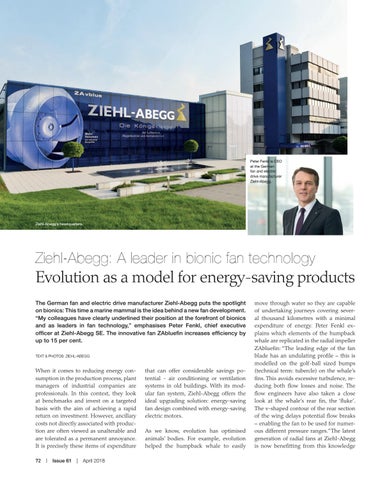Peter Fenkl is CEO at the German fan and electric drive manufacturer Ziehl-Abegg.
Ziehl-Abegg’s headquarters.
Ziehl-Abegg: A leader in bionic fan technology
Evolution as a model for energy-saving products The German fan and electric drive manufacturer Ziehl-Abegg puts the spotlight on bionics: This time a marine mammal is the idea behind a new fan development. “My colleagues have clearly underlined their position at the forefront of bionics and as leaders in fan technology,” emphasises Peter Fenkl, chief executive officer at Ziehl-Abegg SE. The innovative fan ZAbluefin increases efficiency by up to 15 per cent. TEXT & PHOTOS: ZIEHL-ABEGG
When it comes to reducing energy consumption in the production process, plant managers of industrial companies are professionals. In this context, they look at benchmarks and invest on a targeted basis with the aim of achieving a rapid return on investment. However, ancillary costs not directly associated with production are often viewed as unalterable and are tolerated as a permanent annoyance. It is precisely these items of expenditure 72 | Issue 61 | April 2018
that can offer considerable savings potential - air conditioning or ventilation systems in old buildings. With its modular fan system, Ziehl-Abegg offers the ideal upgrading solution: energy-saving fan design combined with energy-saving electric motors. As we know, evolution has optimised animals’ bodies. For example, evolution helped the humpback whale to easily
move through water so they are capable of undertaking journeys covering several thousand kilometres with a minimal expenditure of energy. Peter Fenkl explains which elements of the humpback whale are replicated in the radial impeller ZAbluefin: “The leading edge of the fan blade has an undulating profile – this is modelled on the golf-ball sized bumps (technical term: tubercle) on the whale’s fins. This avoids excessive turbulence, reducing both flow losses and noise. The flow engineers have also taken a close look at the whale’s rear fin, the ‘fluke’. The v-shaped contour of the rear section of the wing delays potential flow breaks – enabling the fan to be used for numerous different pressure ranges.” The latest generation of radial fans at Ziehl-Abegg is now benefitting from this knowledge
